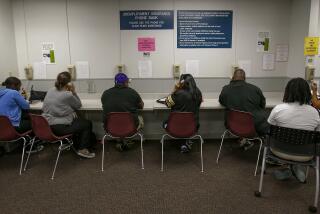Jobless Rate Drops to 5.3%, a 14-Year Low : 3.8 Million Jobs Created in ‘88; Figures Signal More Economic Growth
WASHINGTON — Unemployment dipped to 5.3% in December, matching a 14-year low, the government said today in a year-end report that assured President Reagan of leaving office with joblessness at the lowest point of his presidency.
Nearly 3.8 million jobs were created last year, the most since 1984, and 3 million of them were in service industries.
The jobless rate averaged 5.5% for all of last year, down from 6.2% in 1987.
The Labor Department said December’s unemployment rate was down 0.1 percentage point from November, hitting 5.3% for the third time in 1988, the lowest level since the 5.1% recorded in May of 1974.
Service-producing industries led in the creation of 279,000 new jobs last month. The 3.8 million jobs created during the year were the most since 1984’s total of 3.95 million, the department said.
The numbers reflected continued economic growth and brought renewed talk of higher inflation.
“It shows that the economy has not shifted to a lower gear,” said economist Roger Brimmer of Data Resources Inc., a Lexington, Mass., forecasting service. “With the economy continuing to operate at these levels and continuing to grow as rapidly as it is, inflation is going to keep creeping up.”
Average hourly earnings, however, remained unchanged for the third consecutive month at $9.45. This statistic is closely watched for indications of inflation, but the growth of wages from December, 1987, to December, 1988, was just 3.4%, behind the inflation rate of 4.4%.
Rose to 10.8% in ’82
When Reagan took office in January, 1981, unemployment was 7.5%. It rose to 10.8% late in the 1981-82 recession, the highest level in four decades, before beginning to decline.
Janet Norwood, commissioner of labor statistics, reported that 3 million of the new jobs last year were on the service side of the economy, including 700,000 in retail trade, more than 400,000 in manufacturing and 300,000 in construction.
Rebounding exports helped in manufacturing, particularly the machinery industry. Factory workers continued to average four hours of overtime a week in December.
Of the 279,000 new jobs in December, 107,000 were in the business and health services industries. Retail trade added 52,000 new jobs for the month, most of them in department stores during the Christmas season.
The department said the number of jobless people fell by 9,000 to 6,554,000 last month. It reported that there were 950,000 “discouraged workers”--people who want jobs but who are not included in the unemployment rate because they have given up looking for work in the belief that none is available. That figure has been constant since early 1987.
More to Read
Inside the business of entertainment
The Wide Shot brings you news, analysis and insights on everything from streaming wars to production — and what it all means for the future.
You may occasionally receive promotional content from the Los Angeles Times.









